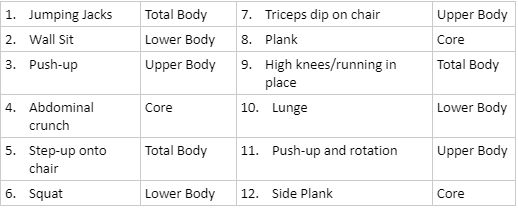High Intensity Training
July 23, 2020

By Marianne Durkin, an SIUE Exercise Physiology Graduate Student Intern
High-Intensity Training (HIT) is a convenient workout option for those with busy days and not a lot of time available for scheduled exercise. It's also great for those who just don't like spending a lot of time in the gym! HIT can be done anywhere in a variety of formats. These HIT type workouts include high-intensity interval training (HIIT), high-intensity circuit training (HICT), and a new trend, Tabata. The time these workouts take can range anywhere from 4-30 minutes making them great options for quick-hit workouts.
What is High-Intensity Interval Training?
High-Intensity Interval Training (HIIT), consists of short, vigorous, aerobic-based exercises performed at ≥80% of one's maximal heart rate to promote cardiorespiratory fitness (1). Aerobic HIIT modalities typically include running or cycling but more recently has expanded to include a variety of cardio heavy, bodyweight exercises (e.g., burpees, jumping jacks, rowing, etc.).
Why Do HIIT?
In a study completed by Tabata et. al., 30 minutes of HIIT was shown to improve anaerobic capacity and oxygen consumption more than that of 60 minutes of moderate-intensity endurance training after a 6 week training period (2). Alongside this, in a 12-week study comparing the benefits induced from high-intensity interval training, strength training only, moderate-intensity training, and a control no-exercise group, it was found that the HIIT group had the greatest improvements in cardiorespiratory fitness and glucose tolerance (an indicator of Type II Diabetes) (3).
In addition to the above benefits, emerging evidence supports the notion that HIIT can also enhance brain function; more specifically, memory and attentional focus (1).
What Does a HIIT Program Look Like?
As mentioned before, HIIT has evolved to include a variety of exercises. Depending on the goal of your workout (e.g., improving power, strength or endurance) will determine the amount of time you work and how much time you rest for the bulk of your workout. For example, if your goal is to improve endurance, you will benefit more from longer work periods (40-60 seconds on) and shorter rest periods (15-20 seconds off).
Example HIIT-style workout:
5-minute warm-up consisting of dynamic exercises (e.g., butt kickers, running in place, lunges)
Round 1: 40 seconds on, 20 seconds rest, 3 rounds
Jumping jacks
Bodyweight squats
Push-ups
Round 2: 30 seconds on, 15 seconds off, 3 rounds
Side plank (each side)
Mountain climbers
Ice skaters
5-minute cool-down
What is Tabata?
Created by Dr. Izumi Tabata, Tabata protocol is a short HIIT that incorporates brief, supramaximal, 20-second intervals into a 4-minute exercise bout (4). The main purpose of Tabata is to use those anaerobic stores as energy. Don't be mistaken, when done correctly, a Tabata workout is brutally hard and requires head-down burst on a stationary bike or rowing machine; explosive bodyweight exercises, or sprints. "If you feel OK afterward you've not done it properly" states Dr. Tabata (5).
Why Do Tabata?
Tabata has been shown to yield notable improvements in aerobic fitness and anaerobic power as well as blood pressure, insulin sensitivity, glucose regulation, and fat loss (4). Tabata-style workouts can be done anywhere and can include a variety of exercises; you can do either bodyweight exercises or go to the gym and hit the resistance machines. Furthermore, Tabata exercises can be modified to a lower intensity and increasing the length of work time. Although not a true Tabata workout when modified, the effort put into the intervals is still very high (80-95% of one's max) (4) and the benefits still significant.
What Does a Tabata-style Circuit Workout Look Like?
Exercises are done in an interval format for 20 seconds of work followed by 10 seconds of rest at ~170% VO2max, repeated eight times for a total of 4 minutes (4). In preparation, incorporate a 10-minute dynamic warm-up with jogging, high knees, jumping jacks, or other multi-muscle exercises (4). For the main part of a Tabata workout, choose exercises that work multiple large muscle groups. For example: jumping jacks, squat jumps, sprints, jump rope, speed skaters, mountain climbers, etc. The options are endless, making Tabata not only a quick HIT workout but a workout that always keeps you on your feet (no pun intended)!
What is High-Intensity Circuit Training?
Similar to HIIT, which is primarily cardio training, high intensity circuit training (HICT) combines both cardio training and resistance training. HICT promotes both cardiorespiratory health alongside muscular fitness. A variety of exercises can be done in a circuit-style whether they be bodyweight exercises, plyometrics, or movements that incorporate the use of equipment (e.g., kettlebells, resistance bands) (1).
Why Do HICT?
HICT is an efficient way to lose weight and fat mass, improve insulin sensitivity, and improve oxygen consumption and utilization by the body. Additionally, improvements in muscular strength, muscular endurance, and hypertrophy can be achieved through HICT.
What Does a HICT Program Look Like?
When doing HICT there are a few things to consider. You want to make sure the exercises selected promote strength and development for large muscle groups, create a balance of strength throughout the body, can be modified as necessary, are safe and appropriate for the participant, and can be easily transitioned from to the next to accommodate for minimized rest time (6). Furthermore, exercises should be placed in an order that allows for opposing muscle groups to alternate between resting and working (6) as seen below in the example workout.
ACSM's Health & Fitness Journal authors have put together a sample HICT program with exercises that target multiple large muscle groups. This circuit workout includes 12 exercises each performed for 30 seconds followed by 10 seconds of rest. Total time is approximately 7 minutes for one circuit and can be repeated 2-3 times (6):

As always, include a proper warm-up before the main exercises as well as a cool-down.
High-Intensity Training Can Improve Markers of Health
Research has shown that HIT can improve cardiovascular health, metabolic health, and aerobic fitness as well as vascular and psychological health (7). Increased cardiorespiratory fitness has been shown to improve body composition, blood pressure, resting heart rate, and inflammatory markers among other things. It has been argued that HIT can elicit greater increases in cardiorespiratory fitness in both healthy and people with cardiometabolic diseases more so than traditional continuous exercises despite reduced total time (1).
Precautions
As with starting any new exercise program, it's important to talk with your physician for clearance. It is not recommended that individuals with hypertension or heart disease do isometric exercises (e.g., wall sits, planks, etc.) (6). Instead, substitute those exercises with a dynamic exercise. Furthermore, because Tabata is as intense as it gets, Dr. Izumi Tabata advises that beginners start with educated trainers so that intensity can be corrected for them (4).
As always, maintain proper technique/form during each exercise and never hold your breath. Additionally, doing too much high-intensity can lead to overtraining and injury. Try mixing up your daily workouts so you're doing different intensities and volumes and targeting different muscles every day.
To sum up, in today's hectic world it can be hard to find time to exercise let alone find a gym you feel safe going to. High-intensity training is a popular, time-efficient, and viable option that elicits overall improvements in health. Try doing a HIT-style workout next time you exercise!
References:
(1) Gibala, M. J., Heisz, J. J., Nelson, A. J., (2018). Interval training for cardiometabolic and brain health. ACSM's Health & Fitness Journal, 22(6), 30-34. https://doi.org/10.1249/FIT.0000000000000428
(2) Tabata, I., Nishimura, K., Kouzaki, M., Hirai, Y., Ogita, F., Miyachi, M., & Yamamoto, K. (1996). Effects of moderate-intensity endurance and high-intensity intermittent training on anaerobic capacity and VO2max. Medicine & Science in Sports & Exercise, 28(10), 1327-1330. https://doi.org/10.1097/00005768-199610000-00018
(3) Nybo, L., Sundstrup, E., Jakobsen, M. D., Mohr, M., Hornstrup, T., Simonsen, L., . . . Krustrup, P. (2010). High-Intensity Training versus Traditional Exercise Interventions for Promoting Health. Medicine & Science in Sports & Exercise, 42(10), 1951-1958. https://doi.org/10.1249/mss.0b013e3181d99203
(4) Olson, M., (2014). Tabata: It’s a HIIT!, ACSM's Health & Fitness Journal, 18(5), 17-24. https://doi.org/10.1249/FIT.0000000000000065
(5) Ingle, S. (2013). The Tabata workout programme: Harder, faster, fitter, quicker? Retrieved from https://www.theguardian.com/lifeandstyle/2013/mar/25/tabata-harder-faster-fitter-quicker
(6) Klika, B., Jordan, C., (2013). High-intensity circuit training using body weight: maximum results with minimal investment. ACSM’s Health & Fitness Journal, 17(3), 8-13. https://doi.org/10.1249/FIT.0b013e31828cb1e8
(7) Kilpatrick, M. W., Jung, M. E., Little, J. P. (2014). High-intensity interval training: A review of physiological and psychological responses. ACSM's Health & Fitness Journal, 18(5), 11-16. https://doi.org/10.1249/FIT.0000000000000067
Categories: All Categories, HIT, HIIT, interval training, internships, exercise













